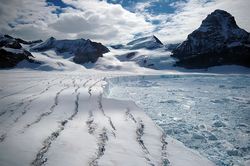Ice shelf collapse study leads to improved models
The purpose of the MODISC (Modelling glacier response after Larsen B ice shelf collapse) project was to improve understanding of glacier and ice sheet dynamics in a warming climate, leading to more reliable forecasts for future sea-level rise. Increased losses of grounded ice have been observed in the Antarctic Peninsula, in particular the Larsen B embayment glaciers following the collapse of the Larsen B ice shelf. Researchers used data concerning the collapse of the ice shelf to validate ice flow models and quantify their performance in reproducing the observed complex response of Larsen B tributaries. Available data from before the collapse of the ice shelf was collected and processed, including ice shelf thickness and bedrock elevations. This information was integrated into an ice dynamics model to simulate the ice flow in the Larsen B area before the disintegration of the ice shelf. The improved data sets were used to better understand the dynamics of coupled glacier/ice shelf systems. Through a combination of improved data sets and improved modelling techniques, MODISC attempted a first-ever simulation of the interaction between floated and grounded ice masses that could be verified through observations. Researchers modelled the instantaneous response of the tributary glaciers to the collapse of the Larsen B ice shelf and the associated loss of buttressing, resulting in grounding line retreat and thinning. The grounding line being the name for ice resting on the bed rock. Scientists found good agreement between modelled changes in glacier flow and observations. This provided improved confidence in the numerical models and their ability to capture the complex mechanical coupling between floating ice shelves and grounded ice. Loss of ice shelf buttressing due to ocean-induced melting and feedbacks associated with grounding line retreat are key processes currently responsible for mass loss from large areas of the West Antarctic Ice Sheet. MODISC increased understanding of these processes by developing a coupled ice-ocean model, which uses input from an ocean model to help determine the ice dynamics. Such an approach provided better results for areas with a complex bathymetry, such as the Pine Island Glacier, and offers new evidence for the importance of bathymetry on glacier retreat and associated changes in ice shelf melt rate. This should lead to important new insights into the recent retreat of the Pine Island Glacier and the associated estimates of sea-level rise.
Keywords
Ice shelf, Larsen B, sea level, MODISC, glacier, ice flow models, grounding line



